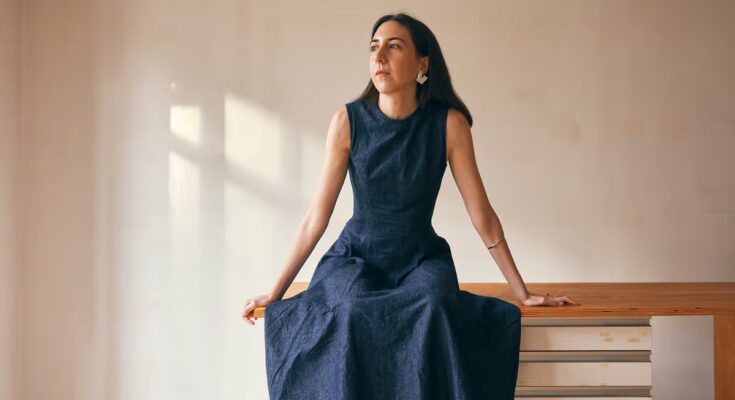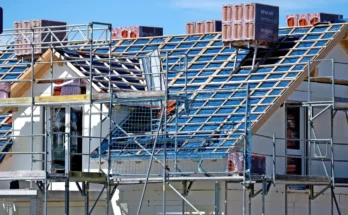Lucia Tahan has just landed in Madrid after a long convalescence. As if in a clumsy and excessive script that no one would believe, on April 18, the day he inaugurated an exhibition in which he participated at the National Museum of 21st Century Arts in Rome, he tripped on the stairs of the Royal Academy of Spain. Unable to walk or reach the museum, she was taken to hospital where she was admitted: she had three broken vertebrae. With rehabilitation and a brace she was able to leave hospital a month later, but due to her delicate health she was detained in Italy for five months. For her it is an experience: “I learned Italian”, she says, “and, leaving the hospital, I met a murderer and a princess”.
The latest work of the architect and augmented reality designer, the installation presented in the museum designed by Zaha Hadid, consisted of a cubic room covered with turquoise spikes, which from the outside looked like something out of a video game. Entering with augmented reality glasses, the coldness of the geometric space was interrupted by a hyper-realistic yet virtual celestial sky. A visitor, at the end of the experience, told him: “It surprises me that when I left I was disappointed by the real world.” The work inverted the codes of physical space (natural, irregular) and digital space (geometric, colourful, measurable). Today, Room with a view (as the installation was titled) was destroyed, and the Roman museum acquired the rights to rebuild it in the future.
The life of Lucia Tahan (Madrid, 36 years old) is frenetic, intense and nomadic. He has lived in Madrid, Jerusalem, Berlin, London, Los Angeles and New York, and in the last year also in Rome. He speaks slowly, he thinks about each answer: “In New York I have a job, but I don’t have a house. But this is kind of the story of my life,” he says, talking about the place he will return to at the end of the year. In addition to being an artist, she works as an interface designer in the United States.
He develops his projects on the computer and they take dimension with virtual reality glasses in galleries or museums. Few artists deal with this technology like she does. Today, despite having multiple applications, virtual reality is best known for its use in fantasy worlds, such as those of video games. Artists such as Space Popular in London, Paula Strunden in Zurich and Yara Feghali in Los Angeles allude to imaginary and dreamlike worlds. Instead, Tahan’s work is highly conceptual and minimalist, focused on the ways in which digital life affects the architecture of real physical spaces. One of his outstanding debts is to collaborate with Elvira Solana, an architect and artist from Santoña who paints murals all over the world.
In his first work with augmented reality, in 2018, he anticipated a phenomenon that was beginning to take shape and is still expanding. It all started with the following question: Just as companies collect and monetize browsing data – the sites visited on the Internet or the time users spend watching a video – won’t they also start collecting spatial data? For example, how much time a person spends sitting on a sofa or which areas of the house they visit most frequently. From that data, could they hypothesize marketing strategies, monetizing human spatial behavior?
Cloud housing was the ironic answer to that question. With virtual reality glasses, viewers could see and aesthetically modify a room, as well as the ability to share spatial data with other users. Regarding this somewhat terrifying possibility, Tahan asked: “Do we want to allow applications to read and save information from our private spaces, like the bedroom?” Seven years later, technologies such as LiDAR are already integrated into mobile phones and cars to measure distances and generate 3D models, and some shopping centers already measure customer trips and length of stay.
Not surprisingly, a year after that job they approached her with proposals to work on designing augmented reality interfaces. He rejected offers from Google and Palantir and between 2018 and 2023 he moved to Los Angeles to become chief designer of Spark AR by Meta (then Facebook), from which the Instagram filters were designed. “This has been the most popular application of augmented reality so far. On the one hand it advances the technology and on the other the products. Artificial intelligence has been around for a long time, but it didn’t become popular until a product emerged that people want to use every day.” As regards the work carried out in recent years in the company, he cannot provide details because, he says, he is still bound by a confidentiality agreement.
Just as Instagram filters change the perception of one’s body, there are sites that only make sense in the virtual world. They are liminal, desolate spaces, like call centers or dark kitchens. The latter, multiplied during the pandemic, prepare food at home in ghost kitchens (often in the basement), and only appear app of food. The public cannot log in and the relationship with customers is entirely digital. It is precisely these spaces, shaped by technologies, that attract Tahan’s gaze, who addresses the way in which technology affects the architecture and construction of real spaces, impoverishing, commodifying and colonizing them. Your research project Ghost omeletteexhibited at the Venice Architecture Biennale in 2023, investigates how interfaces directly affect real built space: the design of app of food delivery, which shows the list of dishes, means that restaurants must only offer food and no longer a room with tables, chairs and service.



